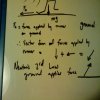I think it's static friction b/c the runner's shoe and the ground are not in continous contact (i.e the runner isn't doing the moonwalk) - when you take off your foot shouldn't slide backward either hence another reason for static. I think the direction of friction strangely enough is in the direction of the net force - to the right going forward. The runner pushes back, and friction opposes this, helping the runner move forward. Not sure how I put this together in my head though. It seems strange as TPR said friction always opposes velocity so TPR would say friction goes backwards.
damn....wait.....the above is for the take off part, but when the runner lands, then friction is going backwards, opposing the runners forward motion. But this time I'm not sure which type of friction it is - i'll go with static again for similar reasons stated above
and going back to thinking about concepts, I am not sure what concept your testing here........ugh
thanks
sv3
Excellent answer!! You definitely have friction down right in ur first paragraph.
"damn....wait.....the above is for the take off part, but when the runner lands, then friction is going backwards, opposing the runners forward motion. But this time I'm not sure which type of friction it is - i'll go with static again for similar reasons stated above"
Here I think ur overanalyzing again!!. Think about when u run do u speed up at takeoff and slow down at landing, NO. Not if u wanna go anywhere fast. When u land u knees are slightly bent and ur center of mass accelerates forward and ur knee moves out in front of ur feet. Da feet then push back on the ground for another take-off. I took a human gait course a while back, i may be rusty on some things but anyhow, this overanalysis is an overkill.
Keep it simple for physics, identify a system and analyze the forces acting on that system. Since we're interested on friction the shoe/pavement interface will work.
Friction can be a confusing concept bcos some books/professors suggests that friction opposes an object's motion which is not necessarily true. Friction opposes
relative motion b/t contiguous surfaces and when the contiguous surfaces are not sliding/"moonwalking" wrt each other, that's static friction otherwise its kinetic. In this problem both horizontal forces (F applied by runner and F applied by ground) are infact frictional (may sound strange). For this question, knowledge of and correct application of the concepts is critical, bcos it seems counterintuitive for friction and displacement to have the same direction, but if u recalled the true definition of friction and assessed the problem to see in what direction da runner's shoe is likely to slide over da ground, then friction's direction will opposite to oppose this sliding. Car tire works da same too!!
Back to ur question, generally I'll break questions in 2 types, one I'll think about concepts b4 and another I won't. Straightforward questions that u've practiced so much that u can do them in ur sleep (Kinematics comes to mind) i dont' think about concept b4 since it's da concept being tested is obvious/explicit but I'll quickly mentally verify whether my answer is reasonable. The second Q type is the one u PAUSE at in the beginning, if u need to pause and think, it's probably bcos the question is too obscure and ur digesting it or ur have competing approaches/concepts u want to apply. Here I'LL DEFINITELY ask myself what basic science concept is being tested? The answer to this is SAVE ME TIME bcos this essentially clarifies and simplifies the question and stops u from running a fool's errand. It's like rephrasing a VR question stem to simplify it, it can only help. MCAT questions can be obscure, esoteric and foggy. I believe points should be award for simply deciphering what the question wants, besides this is half the battle!!
Another benefit of thinking about concepts is some passage-based question might as well be stand-alones bcos the answer has absolutely nothing to do with the passage, now if u reflexively started scouring the passage for a non-existent answer n then rereading the question etc.. u can easily lose a couple of mins. Determining what basic concept was being tested would have saved u precious time and energy. Basically, this is a tool and like any tool, u need to use it when appropriate and not blindly. So IMO using this tool for specific question types will be more efficient and u'll make less mistakes.
For instance:
Shape is important for binding of the relevant peptide to the receptor protein on cell surface, Which AA will best bind to a sterically hindered receptor site?
a. Phenylaline
b. Glycine
c. Histidine
d. Isoleucine
If u look at da question and realize that it's asking you for da smallest AA (in MCAT-speak of course), u will answer it CORRECTLY and QUICKLY, it saves u time and prevents overanalyzing!!
Good luck







